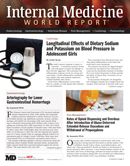Publication
Article
Internal Medicine World Report
Despite Steady Increase in Chemoprophylaxis Use, Annual VTE Incidence Low
Author(s):
Colorectal surgery is often performed for inflammatory disease or malignancy-known risk factors for venous thromboembolism (VTE). Although a patient safety priority, comprehensive recommendations for these VTE patients are lacking. Most patients receive perioperative and in-hospital VTE chemoprophylaxis, but extended prophylaxis rates lag.

Colorectal surgery is often performed for inflammatory disease or malignancy—known risk factors for venous thromboembolism (VTE). Although a patient safety priority, comprehensive recommendations for these VTE patients are lacking. Most patients receive perioperative and in-hospital VTE chemoprophylaxis, but extended prophylaxis rates lag.
Better definitions of specific risk factors and identification of preventive strategies to lower overall VTE risk in this patient population are needed. Thus, there is great interest in finding methods to reduce the rate of VTE in patients undergoing colorectal surgery.
Washington State researchers have published results of a study of a large statewide cohort of patients undergoing colorectal surgery in JAMA Surgery, which examined whether VTE incidence had changed in light of differences in chemoprophylaxis use.
Investigators also aimed to characterize patient, procedural, and postoperative factors associated with VTE in over 16,000 patients from 52 state hospitals who underwent colorectal surgery between January 1, 2006, and December 31, 2011.
They measured VTE complications in-hospital and up to 90 days after surgery.
Among these patients, the use of perioperative and in-hospital VTE chemoprophylaxis increased significantly from 31.6% to 86.4% and from 59.6% to 91.4%, respectively, by 2011 (P <.001). Overall, 10.6% were discharged on a chemoprophylaxis regimen. The incidence of VTE was 2.2%.
Patents undergoing abdominal operations had a higher rate of 90-day VTE versus patients undergoing pelvic operations. Those with operations for cancer had a similar incidence of 90-day VTE compared with those having an operation for nonmalignant processes. Additionally, there was no significant decrease in VTE over time.
Researchers concluded that post-discharge undoubtedly needs quality improvement implementation, because 40% of VTEs occurred during this period. However, future studies are necessary to investigate extended prophylaxis.






